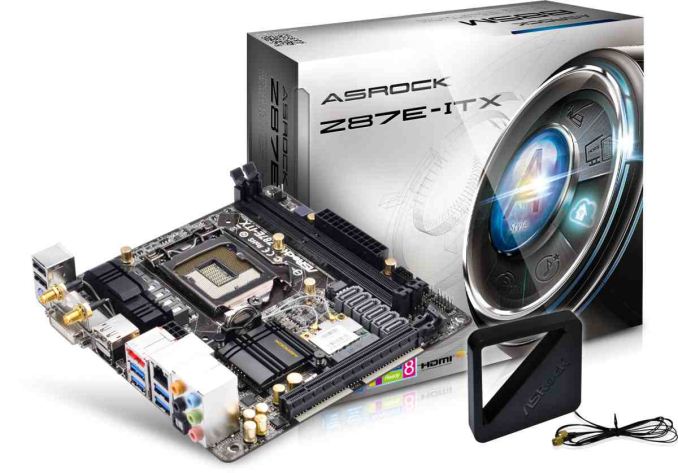ASRock Z87E-ITX Review: Motherboard Juxtaposition
by Ian Cutress on November 6, 2013 10:00 AM EST- Posted in
- Motherboards
- ASRock
- Mini ITX
- Haswell
- Z87
ASRock Z87E-ITX Conclusion
ASRock is definitely making progress on their product lines, in almost all areas: specifications, functionality, software and pricing. ASRock are very aggressive when it comes to pricing, perhaps at the expense of a few aesthetics compared to some other boards. The next step up for ASRock is going to be the creation of their own tools in terms of hardware – their competitors are looking to daughter boards for VRMs, for sound, and for extra features on the Rear IO.
At AnandTech we have previously reviewed the Z87I in the Z87 mini-ITX Haswell arena. Compared to this review, the ASRock is $10 more, has two more SATA 6 Gbps ports, dual band 802.11ac rather than single band 802.11n, only one NIC rather than two but comes with an ALC1150 not an ALC892. The ASRock has a more aesthetically pleasing BIOS than the MSI, they trade blows in software (ASRock has XFast, MSI has Live Update), ASRock has more in-the-box, overclocks further, fundamentally better USB speed but is a bit short on some CPU benchmarks. If I had an extra $10, I would be going with ASRock in that battle.
$150 for a mini-ITX, 802.11ac enabled motherboard, giving good overclock performance but a little down on the CPU out-of-the-box unless you can change a single BIOS setting. It still performs toe-to-toe in gaming benchmarks, with six SATA 6 Gbps, six USB 3.0 ports and a nice BIOS/software package that ASRock has been working on for several generations.
Users wanting a motherboard at $140-160 have a fair few choices as of 11/4:
$140 – MSI Z87I, ASUS Z87-C, MSI Z87-G43 Gaming, GIGABYTE Z87X-D3H
$145 – ASRock Z87 Extreme4, ASUS Z87-A
$150 – ASRock Z87E-ITX
$160 – ASUS Z87-PLUS, GIGABYTE Z87X-UD3H, MSI Z87-G45 Gaming
And other Z87 mini-ITX are available:
$135 – GIGABYTE Z87N-WiFi
$190 – ASUS Z87I-Deluxe
$220 – EVGA Z87 Stinger
$225 – ASUS ROG Z87 Impact
Actually, since I started this review, the Z87E-ITX has a current price drop to $140, putting it right in the mix with the Z87N-WiFi. I have the two ASUS ITX boards as well as the EVGA ITX motherboard in to test over the next few weeks, so stay tuned for those reviews.
However overall I am pleased with the ASRock Z87E-ITX: it surpassed my high expectations in a few important areas (SATA ports, audio codec, overclock performance, 802.11ac) and is well deserving of a recommended award. Another fan header or two, and perhaps an adjustment of that 8-pin CPU power connector might see it hit a full award.
Recommended: ASRock Z87E-ITX at $140












43 Comments
View All Comments
jhoff80 - Wednesday, November 6, 2013 - link
I bought one of these a while ago and it really is a good motherboard. I was having some issues with 1.35V RAM at first, but UEFI version 2.10 cleared that up for me. The Bluetooth part of the 802.11ac/BT module gave me issues as well, but that was all driver-related. Even still, I swapped it out for an Intel part that's performed much better.My biggest issue with the motherboard though, is I really can't believe that Asrock removed their consumer IR header in this generation. I know it's a very niche thing to need, but it'd be perfect for my gaming/media PC. And there's still space for it in the spot it used to be in, they seem to have just decided not to include it this time.
Samus - Wednesday, November 6, 2013 - link
I have the H87 version of this board, and had the same exact problem with 1.35v RAM until the August BIOS update v1.5. That BIOS also fixed a crazy Windows 8.1 (beta at the time) problem causing the event viewer to log a ton of disk IO errors that were in actuality, inert.So far ASRock support has been exceptional. I'm traditionally an ASUS user (and use an Asus H77 ITX board in my file server with a Areca RAID controller) and the BIOS is nearly identical to ASRock. The ASUS software, however, is slightly more "professional" looking, but the XFAN utility and other tools function virtually the same. They're the same company, after all.
But the only problem with the H87 version of this board is four SATA instead of six. Not a problem for my tiny case, but it could be an issue for people with a lot of drives (like a BitFenix case, etc)
Gigaplex - Wednesday, November 6, 2013 - link
"So far ASRock support has been exceptional."I find this hard to believe. I've got an ASRock A75M-HVS as a file server, booting via UEFI. They released a firmware update for Windows 8, which broke UEFI booting for me, so I had to roll back to the older firmware. I emailed their support about it multiple times and never got a response other than their automated "we have received your email and will contact you soon".
Samus - Wednesday, November 6, 2013 - link
The Gigabyte A75 chipset boards have UEFI problems as well, so I think it is more an FM1 chipset problem than a board manufacture problem. But then again, Gigabyte isn't always great with their support either.To be fair to AMD, the A75 was their first chipset to support UEFI so it isn't a shock there are bugs here and there in the same way there were TONS of issues migrating Z68 boards to a UEFI BIOS (many didn't ship with UEFI so it was added to later BIOSes and that was a mess, especially once again for Gigabyte.)
Tull-Power - Thursday, November 7, 2013 - link
Speaking from experience, Asrock do offer excellent support, even on their budget priced boards. I built a number of workstations using the (almost) mini-itx sized G41-VGS3, and after a while noticed that AsRock were releasing updated BIOSes for similar models but not this one. One update improved significantly the CPU fan speed management, something which my users would've appreciated. I e-mailed them and the next day they had sent me a BIOS file with all the updated (including the fan speed) from other models. It flashed flawlessly and considering the rock bottom price, I couldn't be happier.fluxtatic - Sunday, November 10, 2013 - link
Asus spun ASRock off several years ago, along with Pegatron.Lonyo - Wednesday, November 6, 2013 - link
Do the eSATA ports and mSATA ports take away from the 6 ports on the board, or are they in addition to the 6 ports?From the look of it, you're limited to 6 devices total, e.g. 1 eSATA, 1 mSATA and 4 regular or 6 regular and no e/m?
jhoff80 - Wednesday, November 6, 2013 - link
They take away from it. 6 total.Ninhalem - Wednesday, November 6, 2013 - link
Do you have official documentation or something else that backs that up?I've been looking for a long time for a board that has 6 SATA slots and an mSATA for my home server.
kirk444 - Wednesday, November 6, 2013 - link
the user manual will clarify it for you, but the eSATA and mSATA each share a physical SATA port on the board. You are limited to 6 SATA devices.What I've done, is stick a 2 port SATAIII MiniPCI-E HBA into the top-side mPCI-E slot. (I am not using the wi-fi/bluetooth).
I've seen conflicting reports on whether the back-side mPCI-E can be used without disabling the use of the mSATA associated SATA port. My very brief testing seems to show that even if you just use it as a mPCI-E (as in, shove the wireless card on the back side) that you still lose the SATA port. ASRock tech support told me otherwise, but I think they just misunderstood the question.